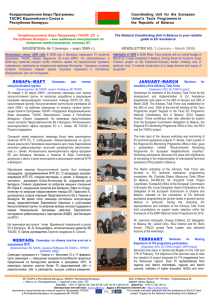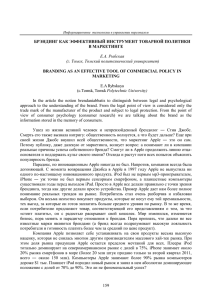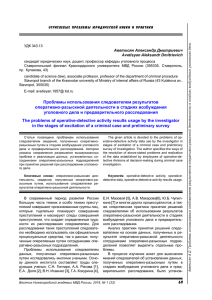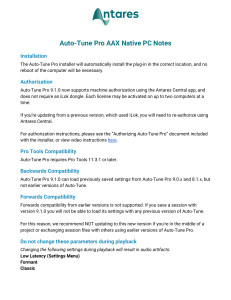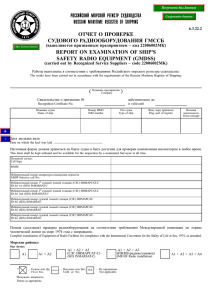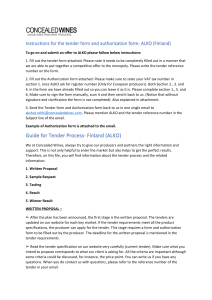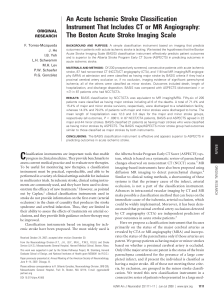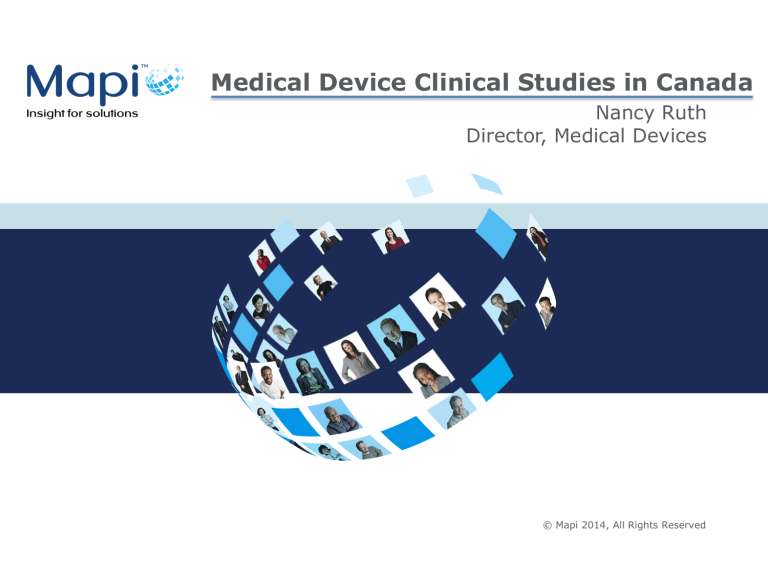
Medical Device Clinical Studies in Canada Nancy Ruth Director, Medical Devices © Mapi 2014, All Rights Reserved Agenda Introduction Agency Medical Devices Regulations and Guidance Ethics Board Approvals ITA Submission Process Health Canada Review Post-Authorization Requirements Importing ITA Devices Inspections Monitoring Similarities/Differences between ITA, CTA Drug, Device Combination Product Studies Summary Questions 2 © Mapi 2014, All rights reserved INTRODUCTION Introduction Medical Devices are regulated based on risk class Class IV – highest risk Class I - lowest risk Manufacturers of Class II, III and IV medical devices must apply for and receive a licence prior to marketing Medical Device Licence applications include administrative requirements, fee and evidence of safety and effectiveness based on the risk of the device - may include clinical evidence If a manufacturer wishes to conduct investigational testing of a Class II, III and IV device on human subjects in Canada, they must apply for and receive an Investigational Testing Authorization (ITA) Class I ITA does not require an ITA approval May be for a new device to Canada or a change in intended use Comparable to Clinical Trial Application for drugs 4 © Mapi 2014, All rights reserved AGENCY Agency Health Canada is the Federal department responsible for helping Canadians maintain and improve their health Therapeutic Products Directorate (TPD) is the Directorate within Health Canada that regulates pharmaceutical drugs and medical devices for human use Health Products & Food Branch Inspectorate (HPFBI) is the branch within Health Canada responsible to compliance and enforcement for regulated products and establishments Within the TPD, the Medical Devices Bureau (MDB) is responsible for regulating all pre-market activities involving medical devices to be manufactured or sold in Canada Device Evaluation Divisions (more detail next slide) Device Licensing Special Access Program Investigational Testing Authorization 6 © Mapi 2014, All rights reserved Agency Cont’d Device Evaluations Divisions (within MDB) Cardiovascular devices Musculoskeletal devices In vitro Diagnostic Devices (IVDD) General and Restorative Devices Scientific review for SAP, ITA and licensing is conducted by the appropriate Device Evaluation Division listed above 7 © Mapi 2014, All rights reserved MEDICAL DEVICES REGULATIONS AND GUIDANCE Food & Drugs Act Statutory basis for regulation Governs the manufacture, distribution, advertising and sale of foods, drugs, cosmetics, medical devices and other therapeutic products in Canada Federal government regulates what can be sold in Canada & the level of control applied Defines “medical device” and “labelling” Specific regulations further define requirements applicable to each type of healthcare product Medical Devices Regulations http://laws.justice.gc.ca/eng/regulations/SOR-98-282/ 9 © Mapi 2014, All rights reserved CMDR SOR/98/282 Section 1 – Definitions Section 2-5 – General Applications Sections 6-7 – Risk Classification Part 1 – General Sections 6-9 – Application & Manufacturer’s obligations Sections 10-20 – Safety & Effectiveness requirements Sections 21-24 – Labelling, Advertising Section 25 – Class I devices 10 © Mapi 2014, All rights reserved CMDR SOR/98-282 Cont’d Section 26-27 – Prohibitions re: import, sale, advertising Section 26-31 – Definition of licencing type Section 32 – Quality system requirements Section 33 – Foreign manufacturers Section 34 – Licence amendments Sections 35-43 – Includes Licence Issuance, suspension, annual renewal Sections 44-51 – Establishment Licence Sections 52-56 – Distribution records 11 © Mapi 2014, All rights reserved CMDR SOR/98-282 Cont’d Sections 57-61 – Complaint handling & MPR reporting Sections 63-65 - Recall Sections 66-68 – Implant registration Part 2 – Custom Made and SAP Devices Part 3 – Investigational Testing Part 4 – Export Certificates (medical devices manufactured in Canada for export only) Part 5 – Transitional, provisions, coming into force 12 © Mapi 2014, All rights reserved Part 3 Investigational Testing Sections 79 & 80 – Application and Scope Sections 81 – Records to be maintained Sections 82 – ITA application requirements Section 83 – Authorization Section 84 – Additional information may be requested by Health Canada during application review Section 85 – Additional information may be requested by Health Canada after issuance of ITA & authorization may be cancelled 13 © Mapi 2014, All rights reserved Part 3 Investigational Testing Cont’d Section 86 – Labelling requirements Section 87 – Advertising of ITA devices Section 88 – references Part I requirements for: Distribution records Complaint handling Mandatory Problem Reporting Recalls Implant registration (limited number of devices) (same requirements as for licensed devices) 14 © Mapi 2014, All rights reserved Guidance ? 1999 guidance documents for IVDD and non-IVDD medical devices Provides application format and limited content requirements Note: Health Canada is drafting a new guidance document for ITA – in pipeline >2yr Dr. Fred Lapner, Head of Investigational Testing (retired this year) and his office have always been quite helpful Bisi Lawuyi has replaced him 15 © Mapi 2014, All rights reserved ETHICS BOARD APPROVALS Research Ethics Board Research Ethics Boards – REB-ERB, MECs, IRB etc. – local (hospital or university based) – regional (like WIRB) - example is IRB Services in Toronto Similar setup - annual renewal of clinical studies REB composition requirements the same as for drug studies per ICH GCP guidelines: Occasionally will see approval for life of study Need annual report At least 5 persons – include both men and women and consider other elements of diversity 2 members with expertise in methods or area of research covered by REB 1 member knowledgeable in ethics 1 member with no affiliation with the institution, from the community served by REB 1 member with knowledge in relevant law Quorum to vote 17 © Mapi 2014, All rights reserved ITA SUBMISSION PROCESS ITA Application Process Who files? When to file? Which devices need ITA? Only the manufacturer of a device may file for an ITA (note consultant, distributor or investigator may submit on manufacturer’s behalf but manufacturer must sign application form and the authorization is issued to the manufacturer.) Device has reasonable probability of safety and effectiveness Completion of appropriate pre-clinical testing, animal studies - varies widely due to range of device types and classifications Novel devices/new technology – helpful to conduct a pre-ITA meeting to obtain agency feedback/agreement with protocol, end points Class II, III, IV Class I does not require ITA Authorization from Health Canada Record requirements Ethics Board Approval is required 19 © Mapi 2014, All rights reserved ITA Submission ITA Submission should include: Cover Letter and Table of Contents Executive Summary ITA Application Form(s) — If investigational devices used in ITA study are manufactured by different manufacturers, more than one submission will be required — If more than one investigational device is used in ITA study, an application form per device will be needed Could require multiple application forms, however generally one ITA submission (one supporting dossier) per study protocol 20 © Mapi 2014, All rights reserved ITA Submission Must advise Health Canada of: Number of devices to be used in the study (for use in Canada, if the study is multijurisdictional) Number of subjects to be enrolled in Canada — Protocol may state total number patients for all sites, all countries ITA Application form does not include a field for these – advisable to clearly state these numbers in your cover letter, Executive Summary and Protocol Description Section 21 © Mapi 2014, All rights reserved ITA Submission Cont’d Investigator Agreement(s) and Investigator CV(s) Class III, IV – submit with the ITA package Class II - maintain on file, provide only if requested by Health Canada Ethics Board approval-Ethics review can be concurrent with Agency review Class III, IV – submit with ITA package Class II – maintain on file, provide only if requested by Health Canada 22 © Mapi 2014, All rights reserved ITA Submission Cont’d Background information or introduction Manufacturer identification – this is the sponsor Device description – sufficient information for understanding of device, how used in study Material specifications Engineering drawings or photographs Name of Institution(s) where the study will be conducted Protocol and informed consent No prescribed format Include Case Report Forms 23 © Mapi 2014, All rights reserved ITA Labelling Requirements Label includes: device marking, package labelling, Instructions For Use, Investigator Brochure (if available) CMDR Labelling requirements for medical devices (Section 21-23) do not apply under ITA Labelling of devices authorized under ITA must include (at a minimum): Name of device Name of manufacturer 2 or 3 required statements in both English and French 24 © Mapi 2014, All rights reserved ITA Labelling Requirements Cont’d Required statements for all ITA devices “Investigational Device” and “Instrument de recherché” “To be Used by Qualified Investigators Only” and “Réservé uniquement à l’usage de chercheurs compétents” In vitro diagnostic device to be used under ITA must also include the following bilingual statements on labelling “The performance specifications of this device have not been established” and “Les spécifications de rendement de l’instrument n’ont pas été établies 25 © Mapi 2014, All rights reserved ITA Submission Cont’d Class III and IV ITA applications also require: Design philosophy Features of the device that permit it to be used for its intended use Performance specifications should be linked with the objectives of proposed testing Comparison to previous generations or competitive devices Marketing history Any previous Special Access requests in Canada Status of the subject device in other jurisdictions Volume of sales and any adverse event or recall information If marketing history of subject device does not exist, provide marketing data for earlier generation device may be helpful in determining safety profile 26 © Mapi 2014, All rights reserved ITA Submission Cont’d Class III and IV ITA applications also require: Risk Analysis and Evaluation ISO 14971 may be referenced Previous studies Preclinical animal and bench studies Biocompatibility studies Medical Electrical safety Clinical Studies in other jurisdictions Literature review may be appropriate Alternate treatments Methods currently used to diagnose and treat the medical conditions that are the subject of the proposed study Precautions Cautions, warnings, contra-indications and possible adverse effects Should also be stated in labelling 27 © Mapi 2014, All rights reserved Specific to IVDD ITAs REB must be submitted to Health Canada for Class II IVDDs if ITA testing includes procedures that pose high risk to the test subject. Class II submission requirements apply to Class II or IV IVDDs NOT for near patient use or NOT for patient management decisions Less risk, less information Additional bilingual investigational labelling statement “The performance specifications of this device have not been established” and “Les spécifications de rendement de l’instrument n’ont pas été établies » 28 © Mapi 2014, All rights reserved Submission Format Application Form Executive Summary Table of Contents 1. Background Information 1.1 Device Description 1.2 Design Philosophy 1.3 Marketing History 2. Risk Assessment 2.1 Risk Analysis and Evaluation 2.2 Previous Studies 2.3 Alternate Treatments 2.4 Precautions Note: some sections not applicable to Class II Tip: list of definition is helpful 3. Institutional Information 3.1 Investigator(s) 3.2 Name of Institution(s) 3.3 Research Ethics Board Approval(s) 4. Protocol 5. Device Label 6. Investigator Agreement(s) 29 © Mapi 2014, All rights reserved Submission to Health Canada 1 paper copy in three ring binder(s) and 1 electronic copy (CD ROM copy preferred) Electronic copy should be provided in a format from which Health Canada can copy Submission should be mailed or couriered to: Bisi Lawuyi Section Head, ITA and Special Access Therapeutic Products Directorate Medical Devices Bureau 2934 Baseline Road, Tower B Address Locator: 3403A Ottawa, ON K1A 0K9 No Fee 30 © Mapi 2014, All rights reserved HEALTH CANADA REVIEW Review of ITA by Health Canada Post submission, an auto-email received from [email protected] “This is to inform you that your application was received and assigned reference #123456” Six digit reference number is referenced on all communications 30 day review target No “default” timeline (different from drug trials) Review is conducted by the ITA office with consult from the Device Evaluation Division specific to the type of device 32 © Mapi 2014, All rights reserved Review of ITA by Health Canada Cont’d Possible communications Screening Deficiency Letter-issued to manufacturer or their regulatory correspondent who will have 15 days to respond to question(s) − Typically for a minor/administrative issue − 30 day timeline starts again once Health Canada received SD Response Additional Information Request-issued to manufacturer or regulatory correspondent who will have 60 days to respond to question(s) − More significant question of safety & effectiveness regarding device or planned study − 30 day timeline starts again once Health Canada received AI Response Also may receive informal call, email for clarification - Issues that can be resolved within 1-2 days; clock doesn’t stop 33 © Mapi 2014, All rights reserved Review of ITA by Health Canada Cont’d Possible communications (cont’d) Letter of Authorization-issued to manufacturer, investigators will be listed on page 2 — May begin enrollment and initiate the trial Refusal/Rejection Letter may be issued if: — The device cannot be used safely for the study; — The study is not in the best interest of the subjects, or — The objectives cannot be achieved A Refusal/Rejection Letter may be appealed Must have letter of authorization to begin enrolling patients No default 30 days Different from CTA/drug studies 34 © Mapi 2014, All rights reserved POST-AUTHORIZATION REQUIREMENTS Post Authorization Additional sites No specific form - submit letter with site/investigator information Class III, IV also submit investigator agreement, CV, REB approval (Class II these are retained unless requested) Health Canada will issue new letter of authorization Different from CTA-drug ie: — CTSI form submitted or implementation of CTA-A (amendment) same form as submitted for sites prior to commencement of CTA — Includes information from REB approval and Qualified Investigator Undertaking (QIU) — Information not typically available at time of CTA/CTA-A submission 36 © Mapi 2014, All rights reserved Post Authorization Cont’d Protocol amendment or significant device changes Mandatory Problem Reporting-(“device incidents” aka Adverse Events-definitions slightly different)-both expected and unexpected Any change to the device which fails outside the risk assessment of the protocol will require a new application A new authorization letter will be issued No specific form – letter with details, supporting information varies according to nature of change Different from CTA (drug) – CTA-A amendment process different from drug – only unexpected AEs Mandatory Problem Report is required if: Related to a failure of the device or deterioration in its effectiveness; OR any inadequacy in its labeling or in its direction for use, AND Has lead to the death or a serious deterioration in the state of health of a patient/user or other person, or could do so were it to recur Notified to Marketed Health Products Directorate 37 © Mapi 2014, All rights reserved Post Authorization Cont’d Note: same criteria as marketed devices Principal investigator must report to manufacturer within 72 hours Manufacturer must report to Health Canada - 10 or 30 day initial report, and closure report (same as marketed devices) Records retention Keep ITA, procedures, distribution, complaints, mandatory problem report, recall records Duration not defined, different from CTA (drug) - Canadian GCP for drugs 25 year retention Recommended to follow this for ITA Advertising-state: Device is subject of investigational testing Purpose of testing 38 © Mapi 2014, All rights reserved IMPORTING ITA DEVICES Importing ITA Devices Shipping documentation should clearly state - investigational devices Include a copy of the ITA Authorization with shipping paperwork Labelling should include ITA references prior to import (required statements) 40 © Mapi 2014, All rights reserved INSPECTIONS Inspections Inspection Program for medical device clinical trials-not developed yet Different from CTA (drug) – inspection process well developed If importer/distributor/Class I manufacturer is being inspected under the Medical Device Establishment Licence inspection program, compliance with CMDR Part 3 is reviewed if ITA product inventory or activities are taking place at the establishment ITA approval letters, import date, labelling of ITA devices, distribution records, mandatory problem reporting and recall requirements reviewed Different from drug clinical trials and FDA clinical trials (IDE) involving medical devices GCP should be followed (ICH guidelines)-not in ITA regulations at present Expected in future revisions of ITA regulations 42 © Mapi 2014, All rights reserved MONITORING Monitoring Clinical trial monitoring as for drug studies PIPEDA and applicable provincial privacy legislation GCP-not addressed in Medical Device Regulations BUT adherence expected Follow ICH guidelines Critical for acceptability of study data in all jurisdictions Sponsors are reminded to register studies in a publicly available registry such as www.clinicaltrials.gov or similar 44 © Mapi 2014, All rights reserved Study Closure Notification to Health Canada is required if study discontinued because of safety issue Closure-while there is no regulatory requirement, the ITA office appreciates notification when an ITA is complete Authorization letters are now requesting a copy of the Final Study Report upon completion of the study (always recommended, but a request we are seeing in ITA approvals since late 2013) 45 © Mapi 2014, All rights reserved SIMILARITIES/DIFFERENCES Between ITA, CTA Similarities to CTA Agency authorization is required for device clinical trials (exception for Class I) Ethics Board Approval and investigator agreement are required Not submitted for CTA but retained in case Health Canada requests Submitted for Class III, IV devices, not for Class II but retained in case Health Canada requests GCP guidelines should be followed - Health Canada GCP, ICH Expected but not yet a regulatory requirement for device ITA Registration with Clinical trial registry is now requested Significant changes to study protocol (ie not editorial) or device, and new sites must be submitted ITA-format for notification not prescriptive – no “amendment” form, process New authorization must be issued before implementing device study change 47 © Mapi 2014, All rights reserved Differences from CTA Phases of drug studies are not typically referenced in medical device studies; numbers of patients typically lower with devices Content of device studies is less prescriptive, more variable – wide range of device types with different types of supporting information eg software vs aortic valve vs insulin pump vs dental implant No default timeline to begin patient enrollment in device studies, Investigational Testing Authorization letter must be received prior to first patient enrollment Manufacturer of a device must file/sign for the ITA, no investigator sponsored studies 48 © Mapi 2014, All rights reserved Differences from CTA Cont’d No Canadian Agent required for foreign manufacturers; no in Canada Senior Scientific Officer or Medical Officer signature needed No differentiation between “expected” and “unexpected” device incidents (adverse events) All are reported Manufacturer of a device must file for the ITA, no investigator sponsored studies If two or more medical devices (manufactured by different companies are) to be used in a study, each manufacturer must apply for an ITA Structure of submissions - CTA more prescriptive (CTD format) 49 © Mapi 2014, All rights reserved DRUG, DEVICE COMBINATION PRODUCT STUDIES Scenarios Combination Products - ITA Needed Device incorporating a drug (eg injectable hyaluronic implant with lidocaine or cortisone, orthopedic implant, cement or wound product with antibiotic, drug eluting stent): Section10 of ITA application form must be completed (name of drug, active ingredient, manufacturer and DIN if applicable) Submission may also require inclusion of drug quality information in ITA (might include Quality Overall Summary-QOS if not a DIN product) Advisable to contact ITA office about the extent of information required to support an ITA Drug information will be reviewed by TPD (pharmaceutical) or BGTD (Biologics and Genetic Therapies Directorate)- no legislated timeline for this; delays are common – impact on planning for authorization, enrolling patients etc Reporting of adverse events-get clarification from Agency, which Bureau wishes to receive reports Typically if product is subject of ITA, Mandatory Problem Reports submitted to MHPD — They communicate to other bureaux as relevant 51 © Mapi 2014, All rights reserved Combination Products – CTA Needed Drug product incorporating a device: examples: drug delivery system (drug in prefilled syringe, IV bag, vaginal ring, metered dose inhaler, implant) Device information may be incorporated into the CTA under section Other Information (Section 1.2.9) Depending on the device/complexity, may be brief or extensive Some cases, section is equivalent to technical content of ITA Medical Devices Bureau consultation review Advisable to contact the Office of Clinical Trials about the extent of device information required May also need to contact the Medical Devices Bureau Device information will be reviewed by Medical Devices Bureau Reporting of adverse events-get clarification from Agency, which Bureau(x) wishes to receive reports 52 © Mapi 2014, All rights reserved Devices in Drug Studies - CTA and ITA Needed A drug study which uses unlicensed devices, but not as a combination product – example: in vitro diagnostic device for study subject evaluation licensed in other jurisdictions where there are study sites-sponsor wants consistency of results Authorization needed to use the unlicensed device in the drug CTA Separate ITA must be filed in parallel with the drug CTA Same protocol, even though the objective of the study/end points are NOT about the device Must be signed by the device manufacturer, not the drug CTA sponsor 53 © Mapi 2014, All rights reserved Devices in Drug Studies Cont’d Other examples of unlicensed devices used in a drug study: Photodynamic therapy – laser, fibre-optic used to activate drug administered to patient Software used in dosing/determination or evaluation of study patients Sometimes have been treated as separate ITA, other times device information has been incorporated into the CTA Consult with the Office of Combination Products, Medical Devices Bureau on current thinking, preference 54 © Mapi 2014, All rights reserved Devices in Drug Studies Cont’d Where separate ITA must be filed in parallel with the drug CTA: As noted, same protocol, even though the objective of the study/end points are NOT about the device Must be signed by the device manufacturer, not the drug CTA sponsor Can add complexity – device manufacturer may/may not be willing to accept responsibility for their product used in a clinical trial – may not agree to sign Alternatives: — ask device manufacturer to file a Health Canada licence application — Issues - global strategy, CMDCAS certificate, etc. — Choose an already-licensed equivalent product — Issues: consistency in a global study, volume pricing etc. 55 © Mapi 2014, All rights reserved Devices in Drug Studies Cont’d Licensed devices used in drug studies – acquired by sponsor for the study sites drug administration devices (syringes, needles) Specimen collection devices (blood collection tubes, needles, urine cups) Near patient in vitro diagnostic devices (glucose meters, strips, urinalysis strips) May be imported from outside Canada or obtained from a domestic source Importation/distribution regulated through Medical Device Establishment Licensing (MDEL) Responsibility to hold MDEL may fall on sponsor Regulatory obligations for licence application, fees, records, recalls, HPFBI MDEL inspection If no MDEL, could be cited in CTA HPFBI site inspection Order, pay, store, provide to site (or drop ship) 56 © Mapi 2014, All rights reserved Drugs in Device Studies Cont’d Investigation device(s) used in study with approved drug(s): Two unlicensed devices, different manufacturers-continuous glucose monitor/sensor, insulin pump – closed loop when used together 2 insulin products, Health Canada approved for use with the pump 2 x ITA needed, no CTA (on-label use) — Cite DIN(s), no other information provided One body of supporting information — Proprietary information issue between the manufacturers — Strategies to protect, ensure confidentiality — Manufacturer copies, Health Canada Patients used prescribed insulin(s) dosage treatment with drugs integral to the execution of protocol, study outcome but not part of the endpoints or study authorization 57 © Mapi 2014, All rights reserved Drugs in Device Studies Cont’d Investigational device(s) used in study with approved drug(s): IT needed, no CTA (on-label use) — Cite DIN(s) Study used software + continuous glucose monitor/sensor + transmitter + insulin pump + glucose meter + ketone meter + 2 different insulin products Some devices licensed, some not licensed (including software - also a device) — 2 separate ITAs – we submitted on behalf of one manufacturer, the other submitted by its manufacturer — Licensed devices were citied with Health Canada MDL#s — Drug DINs were citied Patients use prescribed insulin(s) dosage Software interfaces with other devices to adjust insulin dosing according to blood glucose level detected, prevent nocturnal hypoglycemia (dangerous) No drug information in ITA submission, other than to cite insulin names, DINs Drugs integral to the execution of protocol, study outcome but not part of the endpoints or study authorization 58 © Mapi 2014, All rights reserved SUMMARY Summary Similarities and differences between Investigational Device Authorization, Clinical Trial Applications but goals of regulations aligned Protect study subjects Permit collection of data to support marketing application, further research, product development Ensure reasonable chance of success Complexities where drugs and devices are used together Case by case, agency preferences, interpretations where regulations do not address evolving technologies, treatments Planning should consider potential delays Help is available! Medical Devices Bureau Office of Clinical Trials Experienced internal resources, consultants 60 © Mapi 2014, All rights reserved QUESTIONS THANK YOU! [email protected]
